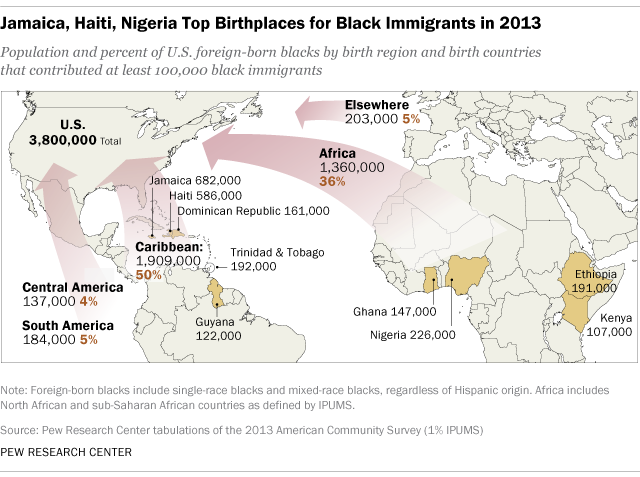| |||||||||
|
|||||||||
|
By:
MONICA ANDERSON | |||||||||
| Posted:
Apr,27-2015 10:51:48
| |||||||||
|
A record 3.8 million black immigrants live in the United States today, more than four times the number in 1980, according to a Pew Research Center analysis of U.S. Census Bureau data.Black immigrants now account for 8.7% of the nation’s black population, nearly triple their share in 1980.
Rapid growth in the black immigrant population is expected to continue. The Census Bureau projects that by 2060, 16.5% of U.S. blacks will be immigrants.1In certain metropolitan areas, foreign-born blacks make up a significant share of the overall black population.For example, among the metropolitan areas with the largest black populations, roughly a third of blacks (34%) living in the Miami metro area are immigrants. In the New York metro area, that share is 28%. And in the Washington, D.C., area, it is 15%.
However, much of the recent growth in the size of the black immigrant population has been fueled by African immigration. Between 2000 and 2013, the number of black African immigrants living in the U.S. rose 137%, from 574,000 to 1.4 million.Africans now make up 36% of the total foreign-born black population, up from 24% in 2000 and just 7% in 1980. Among black immigrants from Africa, virtually all are from sub-Saharan African countries, with only 1% of all black immigrants from North Africa.Nigeria, with 226,000 immigrants, and Ethiopia, with 191,000, are the two largest birth countries for black African immigrants to the U.S. Black immigrants have roots in other parts of the world as well.Some 5% of all black immigrants are from South America and 4% are from Central America;those from Europe make up 2% of the population and those from South and East Asia make up 1%.3
The History of Black Migration to the U.S.The United States has long had a significant black population.4In the nations earliest censuses (at the end of the 18th century), blacks accounted for nearly one-fifth of the U.S. population, with nearly all brought to the U.S. as slaves from Africa. Today, most of the nation's 40 million U.S.-born blacks trace their roots to this population. However, due to the outlawing of the slave trade in 1808 as well as restrictions on non-European immigration, the flow of blacks arriving in the U.S. dropped to a trickle for more than a century and a half. Among the black immigrants who voluntarily migrated during this time, most were from the Caribbean.
This act, also known as the diversity visa program, has been an important way for African immigrants to gain entry into the U.S. About one-in-five sub-Saharan African immigrants (19%) who gained legal permanent residence between 2000 and 2013 entered through this program. During the same period, about three-in-ten (28%) sub-Saharan African immigrants arrived in the U.S. as refugees or asylees. That share was only 5% for Caribbean immigrants and 13% for the overall immigrant population. Caribbean immigrants are much more likely to enter the U.S. through family-sponsored Caribbean and sub-Saharan African immigrants are less likely to have been granted admittance via employment-based visa programs than immigrants overall. A Statistical Portrait of Black Immigrants
Black immigrants share some similarities with the overall U.S. immigrant population in terms of their median ages and poverty rates.However, black immigrants are somewhat more likely to hold U.S. citizenship than all immigrants :54% versus 47%.Given that many black immigrants are from English-speaking Caribbean nations, they're also more likely to be proficient in English compared with all immigrants (74% versus 50%). Black immigrants are also less likely to be in the U.S. illegally than all immigrants (16% versus 26%). Compared with the U.S. population overall, black immigrants have a slightly higher median age (42 years versus 37 years) and among those that are ages 25 and up, are slightly less likely to have a college degree (26% versus 30%). In addition, black immigrants are less likely than all Americans to own their homes (40% versus 64%), and overall they have lower household incomes. These findings are based on a Pew Research Center analysis of data from the 2013 American Community Survey in addition to analyses of the 1980, 1990 and 2000 U.S. decennial censuses. The report explores the characteristics of the nation's black immigrant population in 2013 and how it has changed since 2000. It also compares the characteristics of black immigrants with those of U.S.-born blacks, all U.S. immigrants and the U.S. population. | |||||||||
|
Source:
| |||||||||
|
||||||||||||||||||||||||||||||||||||||||||||||||||||||||||||||||||||||||||||||||||||||||||||||||||||||||||||||
|
||||||||||||||||||||||||||||||||||||||||||||||||||||||||||||||||||||||||||||||||||||||||||||||||||||||||||||||


.jpg)









